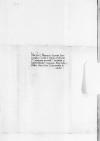Dici nequit, quam dolenter cum multis hic duplici sim affectus maerore, cum ob ⌊sancti regis nostri⌋ obitum, tum ex rumore huc paulo ante ad nos perlatum, qui cum publice ubique evulgatus est, non eget descriptione. Non potui mihi itaque temperare, postquam ad eum modum a domino Deo clementius quam merui castigor, quod neque curru neque equo vehi valeam facultasque ad aulam proficiscendi pro exsolvendis regiis iustis ac Ill(ustrem) or Ill(ustrissimam)⌈Ill(ustrem)Ill(ustrem) or Ill(ustrissimam)⌉ Magnificentiam Vestram videndi mihi prorsus sit adempta, quin, quod ipse coram praestare nequeo, litteris saltem Ill(ustrem) or Ill(ustrissimam)⌈Ill(ustrem)Ill(ustrem) or Ill(ustrissimam)⌉ Magnificentiam Vestram inviserem, quam pro veteri illa mea in eandem observantia salubriorem ac viribus esse firmiorem, quam ego sim, ex animo cupidissime opto, ne cum accessu aetatis ea, quae mihi accesserunt,
umquam experiatur. In hac afflictione me totum divinae voluntati subdidi, cuius dispositionem minime diuturnioris vitae avidus patienter expectabo, cum videam multa agi praepostere et mundum in maligno versari atque plerosque his rebus adminiculari, quibus se ponere deberent obiicem, qui privatis commodis pro se et suis intenti omnem de republica curam abiecerunt, non considerantes, cum hoc negligunt, quod commune habent cum omnibus, sibi ipsis paulo post detrimentum illaturos. Sed de iis ad Ill(ustrem) or Ill(ustrissimam)⌈Ill(ustrem)Ill(ustrem) or Ill(ustrissimam)⌉ Magnificentiam Vestram, quae haec singula propius perspicit, confidenter hactenus.
Nos hic etiam varia, quae circumferuntur, perturbant, de quibus pauca attingam, eo quod non satis tutum
sit omnia credere calamo. Huc ad ⌊vicinum meum⌋ plerique hospites confluunt, nuper appulerunt comites ⌊de Mansfelt⌋ et ⌊Hohenloe⌋, fuit etiam novissime apud illum per aulicum adductus, ⌊marchionis Alberti⌋ ⌊Cazimiri⌋ filii ms. um(!)
⌈ii ms. um(!)
⌉, Italus quidam ⌊Ludovicus Montius Mutinensis⌋, qui ex ⌊Monteregio⌋ versus ⌊Cracoviam⌋ proficiscens, huc ad me diverterat et vix per horae spatium apud me immoratus coeptum suum iter continuavit. Ille dicebat se a ⌊maiestate regia⌋ recta ad ⌊regem Romanorum⌋ iturum, de negotiis porro suis nihil emittebat, nisi cum a meis deduceretur, illis dixerat, quod per me inter illos principes multa bona fieri possent, et inde statim conticuit nihil addens. Quid sibi ista velint, non satis intelligo, monstri aliquid ali existimo. Nos inter spem et metum volvimur. Perfertur ad nos compromisso per dominum ⌊palatinum Siradiensem⌋ a ⌊caesare⌋ obtento fidendum non esse post ⌊sancti regis⌋ e vivis excessum. Subinde rumusculi sparguntur conventum esse cum ⌊caesare⌋, ut status Prussiae sic quietus maneat, ut nunc est, usque ad mortem ⌊vicini principis⌋. Post eam ordo debeat hic restitui et ⌊filia⌋, si vivente ⌊patre⌋ nuptui non tradetur, a ⌊caesare⌋ dotari. Sicque inter sacrum et saxum, quid credendum sit, nescitur.
Ab Illustri igitur Magnificentia Vestra impense oro pro veteri in me illa sua benevolencia me celare non velit, si quid in iis certi habuerit, et hoc potissimum, quicquid hoc sit, quod dominus ⌊palatinus Siradiensis⌋ reportaverit, et quid nobis sit sperandum in iis, quae adeo perplexe, tum ex regno, tum etiam ex aliis regionibus ad nos perducuntur. Obstringo Ill(ustri) or Ill(ustrissimae)⌈Ill(ustri)Ill(ustri) or Ill(ustrissimae)⌉ Magnificentiae Vestrae fidem meam, quaecumque de iis confidenter perscripserit, secretissimum me habiturum. Quam oro, ut item et hanc meam scriptionem contineat. Cui cupio esse commendatissimus atque omnia exopto faustissima.


 UUB, H. 155, f. 212v
UUB, H. 155, f. 212v